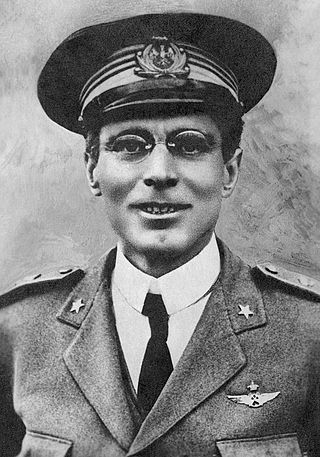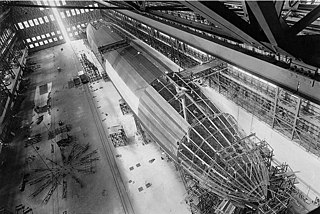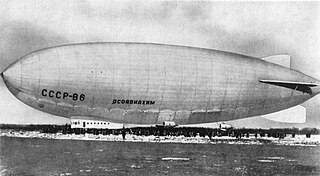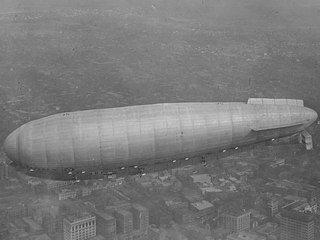
A blimp (/blɪmp/), or non-rigid airship, is an airship (dirigible) without an internal structural framework or a keel. Unlike semi-rigid and rigid airships, blimps rely on the pressure of the lifting gas inside the envelope and the strength of the envelope itself to maintain their shape. Blimps are known for their use in advertising, surveillance, and as observation platforms due to their maneuverability and steady flight capabilities.

An airship is a type of aerostat or lighter-than-air aircraft that can navigate through the air flying under its own power. Aerostats use buoyancy from a lifting gas that is less dense than the surrounding air to achieve the lift needed to stay airborne.

Umberto Nobile was an Italian aviator, aeronautical engineer and Arctic explorer.

The Norge was a semi-rigid Italian-built airship that carried out the first verified trip of any kind to the North Pole, an overflight on 12 May 1926. It was also the first aircraft to fly over the polar ice cap between Europe and America. The expedition was the brainchild of polar explorer and expedition leader Roald Amundsen, the airship's designer and pilot Umberto Nobile and the wealthy American adventurer and explorer Lincoln Ellsworth who, along with the Norwegian Aviation Society, financed the trip, which was known as the Amundsen-Ellsworth 1926 Transpolar Flight.

A rigid airship is a type of airship in which the envelope is supported by an internal framework rather than by being kept in shape by the pressure of the lifting gas within the envelope, as in blimps and semi-rigid airships. Rigid airships are often commonly called Zeppelins, though this technically refers only to airships built by the Luftschiffbau Zeppelin company.

SSSR-V6 OSOAVIAKhIM was a semi-rigid airship designed by Italian engineer and airship designer Umberto Nobile and constructed as a part of the Soviet airship program. The airship was named after the Soviet organisation OSOAVIAKhIM. V6 was the largest airship built in the Soviet Union and one of the most successful. In October 1937, V6 broke the world record for airship endurance previously held by the Graf Zeppelin; under the command of Ivan Pankow, the airship remained aloft for 130 hours 27 minutes.

The Airship Industries Skyship 600 is a modern airship, originally designed by British company Airship Industries, further developed by a subsidiary of Westinghouse Electric Corporation. The type certificate holder is now Skyship Services of Orlando, Florida.

Paul Haenlein was a German engineer and flight pioneer. He flew in a semi-rigid-frame dirigible. His family belonged to the Citoyens notables, those notabilities who led the economy, administration and culture of Mainz.

Roma was an Italian-built semi-rigid airship, designated by its designer as the Model T-34. Purchased by the United States from the Italian government in 1921, Roma was operated for three months by the United States Army Air Service from November 15, 1921 to February 21, 1922, when it crashed in Norfolk, Virginia, killing 34 crewmen and passengers aboard, with 9 survivors. As a result of this accident, Roma was the last hydrogen inflated airship flown by the US military; all subsequent US Army and Navy airships were inflated with non-flammable helium.

A ballonet is an inflatable bag inside the outer envelope of an airship which, when inflated, reduces the volume available for the lifting gas, making it more dense. Because air is also denser than the lifting gas, inflating the ballonet reduces the overall lift, while deflating it increases lift. In this way, the ballonet can be used to adjust the lift as required.
Gross-Basenach or Groß-Basenach is the designation for a series of five so-called M-class German military semi-rigid airships constructed by balloonist Nikolaus Basenach and Major Hans Georg Friedrich Groß (1860–1924) of the Royal Prussian Airship Battalion Nr 2 between 1907 and 1914.

The Lebaudy Patrie was a semi-rigid airship built for the French army in Moisson, France, by sugar producers Lebaudy Frères. Designed by Henri Julliot, Lebaudy's chief engineer, the Patrie was completed in November 1906 and handed over to the French army the following month. The Patrie bears the distinction of being the first airship built specifically for military service.

This article outlines some of the non-rigid and semi-rigid airships used in or built in Russia and the Soviet Union.

Lebaudy République was a semi-rigid airship built for the French army in Moisson, France, by sugar manufacturers Lebaudy Frères. She was a sister ship of the airship Patrie, the main differences between the two being in the dimensions of the gasbag and the ballonet. Although she was operationally successful, République crashed in 1909 due to a mechanical failure, killing all four crew members.

The Goodyear RS-1 was the first semi-rigid airship built in the United States. The dirigible was designed by chief aeronautical engineer and inventor, Herman Theodore Kraft of the Goodyear Tire and Rubber Company for the United States Army Air Service in the late 1920s. Goodyear built only one airship of this type.

The Lebaudy Morning Post was a French semi-rigid airship built for the British Army in Moisson, France, by manufacturers Lebaudy Frères. The airship was commissioned by the newspaper The Morning Post, who created a fund to purchase the airship and present it to the British Army. The airship's envelope was damaged on the delivery flight and then it was destroyed on a subsequent trial flight after repair. At the time of construction it was the largest airship that had been built in France.

The Au-30 "Argus" is a non-rigid dirigible. As of June 2017, it holds the official world record for non-stop flight distance for non-rigid airships with a volume between 3,000 and 6,000 m3. In 2009–2010, it is the world record holder in six classes of non-rigid airships under the FAI from BA-05 to the absolute BA-10.
















